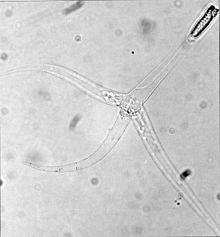
Myxozoa

Myxozoa (etymology: Greek: μύξα myxa 'slime' or 'mucus' + thematic vowel o + ζῷον zoon 'animal') is a class of aquatic, obligately parasitic cnidarian animals. Over 1300 species have been described and many have a two-host lifecycle, involving a fish and an annelid worm or a bryozoan. The average size of a myxosporean spore usually ranges from 10 μm to 20 μm, whereas that of a malacosporean (a subclade of the Myxozoa) spore can be up to 2 mm. Myxozoans can live in both freshwater and marine habitats. While the evolutionary history of myxozoans is still an active area of research, it is now understood that myxozoans are highly modified cnidarians that have undergone dramatic evolution from a free swimming, self-sufficient jellyfish-like creature into their current form of obligate parasites composed of a mere handful of cells. As myxozoans evolved into microscopic parasites, they lost many genes responsible for multicellular development, coordination, and cell-cell communication. The genomes of some myxozoans are now among the smallest genomes of any known animal species. Myxozoans were originally considered protozoan, and were included among other non-motile forms in the group Sporozoa. As their distinct nature became clear through 18S ribosomal DNA (rDNA) sequencing, they were relocated in the metazoa. Detailed classification within the metazoa was however long hindered by conflicting rDNA evidence: although 18S rDNA suggested an affinity with Cnidaria, other rDNA sampled, and the HOX genes of two species, were more similar to those of the Bilateria. The discovery that Buddenbrockia plumatellae, a worm-like parasite of bryozoans up to 2 mm in length, is a myxozoan initially appeared to strengthen the case for a bilaterian origin, as the body plan is superficially similar. Nevertheless, closer examination reveals that Buddenbrockia's longitudinal symmetry is not twofold, but fourfold, casting doubt on this hypothesis. Further testing resolved the genetic conundrum by sourcing the first three previously identified discrepant HOX genes (Myx1-3) to the bryozoan Cristatella mucedo and the fourth (Myx4) to Northern pike, the respective hosts of the two corresponding Myxozoa samples. This explained the confusion: the original experiments had used samples contaminated by tissue from host organisms, leading to false positives for a position among the Bilateria. More careful cloning of 50 coding genes from Buddenbrockia firmly established the clade as severely modified members of the phylum Cnidaria, with medusozoans as their closest relatives. Similarities between myxozoan polar capsules and cnidarian nematocysts had been drawn for a long time, but were generally assumed to be the result of convergent evolution. Taxonomists now recognize the outdated subgroup Actinosporea as a life-cycle phase of Myxosporea. Infection occurs through valved spores. Each of these contain one or two sporoblast cells and one or more polar capsules that contain filaments which anchor the spore to its host. The sporoblasts are then released as a motile form, called an amoebula, which penetrates the host tissues and develops into one or more multinucleate plasmodia. Certain nuclei later pair up, one engulfing another, to form new spores. Relationships between myxosporeans and their hosts are often highly evolved and those do not usually result in severe diseases of the natural host. Infection in fish hosts can be extremely long-lasting, potentially persisting for the lifetime of the host. However, an increasing number of myxosporeans have become commercially important pathogens of fish, largely as a result of aquaculture bringing new species into contact with myxosporeans to which they had not been previously exposed and to which they are highly susceptible. The economic impact of such parasites can be severe, especially where prevalence rates are high; they may also have a severe impact on wild fish stocks.
